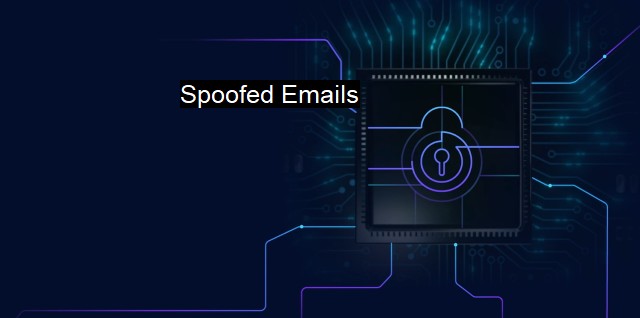What are Spoofed Emails?
The Danger of Spoofed Emails: A Common Weapon for Cyber Attackers Targeting Unsuspecting Victims
Spoofed Emails are among the most common tactics used by cybercriminals to trick unwitting individuals into obtaining unauthorized access to sensitive personal information. These deceptive practices fall under a broad cyberattack category known as phishing. In order to ensure personal and professional digital safety, it's necessary for individuals to understand what spoofed emails are, how they work, and how they are interlinked with the field of cybersecurity.A spoofed email, at its core, is an email which is disguised or altered to appear as if it has been sent from a legitimate or trustworthy source. This honestly could be a reputable organization, a colleague, friend or even a digital service provider. By exploiting trust of the presumed source, cybercriminals can encourage individuals to reveal highly sensitive information such as login credentials, credit card details, and social security numbers.
Spoofed emails are oftentimes meticulously crafted to look identical to correspondence from a trusted entity. The actual sender email address might be shown as anything from a personal contact to a big-name enterprise like a bank, government agency or tech giant. The intent is to get someone to open the email, trust its content and impulsively obey its call to action, which is typically interfacing with a suspicious hyperlink or downloading a malicious attachment.
The interplay between spoofed emails and cybersecurity reveal a creeping menace that lurks in both professional and personal digital environments. Despite the proven damage potential of spoofed emails, they still continue to be increasingly prevalent as a strikingly successful form of cyberattack, primarily because they exploit human weaknesses, such as lack of awareness or complacency, more than they do software vulnerabilities.
Upon landing in an inbox, spoofed emails disrupt the security of the device, either by enabling remote control or installing malware or both. This break in digital security composing an offense and counter-offense model of a primary cybersecurity concern. Many cybersecurity infrastructures deal with hefty costs in efforts to intercept and combat this form of intrusion, covering system tailoring, deployment and monitoring.
Evidently, the hazardous impacts of spoofed emails make it necessary to arm oneself not only with protective measures of an antivirus application installed, but also with vital knowledge to discern genuine from counterfeit. Antivirus is an essential line of defense against adverse activity likely to be initiated by a spoofed email. Advanced antivirus software can scan suspicious email content, including attachments and links, before any action is performed – a crucial preemptive protection when protection after the fact might be too late.
It will often alert users of email with red flags while enabling unaffected digital interactions by analyzing and deciphering the inherent characteristics of an email and its associated sender. Advanced features in high-end antivirus applications streamline the process of diffusing risk carried by spoofed emails, such as phishing detection systems. They scan email headers and content and warn users when they sense a well-disguised trap.
Antivirus software alone cannot ensure complete safety from email spoofing due to limitations and the ingenious methods used by cybercriminals. Therefore, awareness training amongst users about spoofing techniques and safety procedures like double-checking email addresses or touch-basing with apparent senders become indispensable.
Being equipped with cybersecurity awareness, modern antivirus software, and maintaining a perpetual degree of skepticism towards all incoming emails, significantly help safeguard against the ever-evolving threat of spoofed emails. Given the potential devastation that this seemingly harmless form of attack can cause, continued vigilance in staying one step ahead of cyber attackers remains everyone's shared responsibility.

Spoofed Emails FAQs
What is a spoofed email?
A spoofed email is an email message that appears to have been sent from a legitimate source but, in reality, was sent from a fraudulent source. Spoofed emails are often used in phishing attacks, where the attacker tries to trick the recipient into revealing sensitive information.How can I identify a spoofed email?
Some signs of a spoofed email include a slightly altered domain name (for example, @gmall.com instead of @gmail.com), a suspicious sender email address, a generic greeting instead of a personalized one, or urgent requests for personal or financial information.How can I protect myself from spoofed emails?
You can protect yourself from spoofed emails by using antivirus and spam filters, not responding to suspicious emails, not clicking on links or downloading attachments from unknown senders, and verifying the legitimacy of requests for sensitive information.What should I do if I receive a spoofed email?
If you receive a spoofed email, do not respond to it, and do not click on any links or download any attachments. Instead, report the email to your organization's IT department or to the appropriate authorities, and take steps to protect your personal and financial information.| | A | | | B | | | C | | | D | | | E | | | F | | | G | | | H | | | I | | | J | | | K | | | L | | | M | |
| | N | | | O | | | P | | | Q | | | R | | | S | | | T | | | U | | | V | | | W | | | X | | | Y | | | Z | |
| | 1 | | | 2 | | | 3 | | | 4 | | | 7 | | | 8 | | |||||||